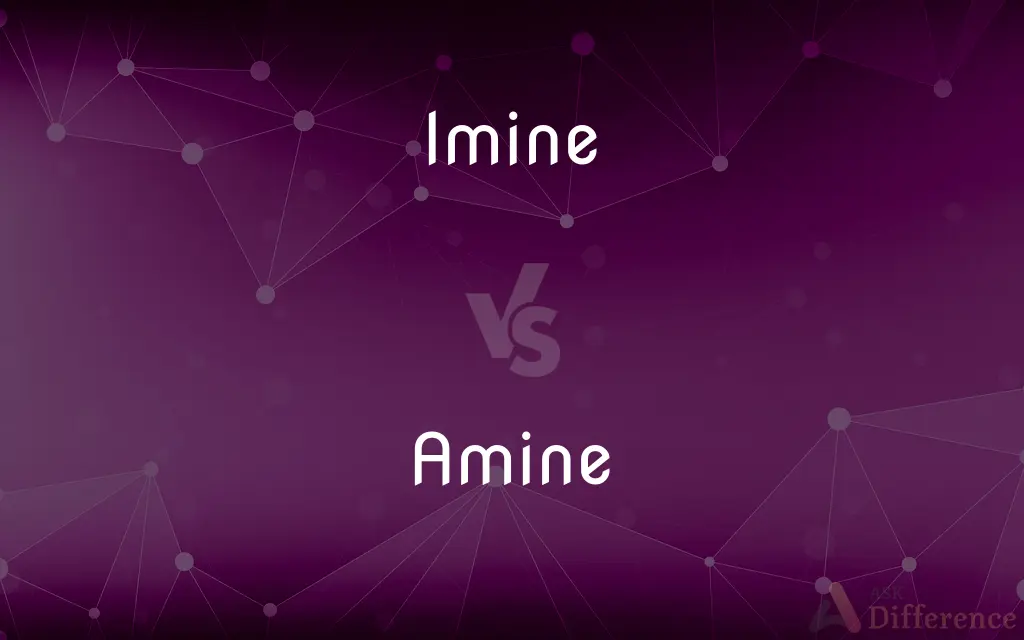Imine vs. Amine — What's the Difference?
Edited by Tayyaba Rehman — By Fiza Rafique — Updated on April 7, 2024
Imine is a functional group characterized by a carbon-nitrogen double bond, while amine involves a single bond between nitrogen and carbon or hydrogen.

Difference Between Imine and Amine
Table of Contents
ADVERTISEMENT
Key Differences
Imines are organic compounds featuring a carbon-nitrogen double bond often resulting from the condensation of a primary amine and an aldehyde. Amines, on the other hand, are characterized by their single-bonded nitrogen atom connected to carbon or hydrogen atoms, making them derivatives of ammonia.
While imines serve as intermediates in various organic syntheses, such as the synthesis of amines, amines are foundational in both natural and synthetic compounds. Amines are prevalent in amino acids, pharmaceuticals, and dyes, underlining their versatility and importance in chemistry and biology.
In terms of reactivity, imines are typically more reactive than amines due to their double bond, which makes them susceptible to nucleophilic attacks. This reactivity is exploited in many chemical reactions, such as the reductive amination process to produce amines. Amines, being less reactive, are often the target product of reactions involving imines.
The physical properties of imines and amines also differ. Imines are generally less soluble in water compared to amines, due to the polar nature of the bond and the lack of hydrogen bonding as compared to amines, which often engage in hydrogen bonding due to the groups.
Biologically, amines play a crucial role as neurotransmitters, alkaloids, and hormones. Imines, while not as prevalent in biological systems, are important in the biosynthesis of various natural products and as intermediates in metabolic pathways.
ADVERTISEMENT
Comparison Chart
Bond Type
Carbon-nitrogen double bond (=C=N).
Carbon-nitrogen single bond (−C−N) or nitrogen-hydrogen (−N−H).
Reactivity
More reactive, susceptible to nucleophilic attacks.
Less reactive, often the end product in synthetic pathways involving imines.
Occurrence
Intermediate in organic syntheses.
Widespread in nature and synthetic compounds, including pharmaceuticals and dyes.
Solubility
Generally less soluble in water.
More soluble in water due to hydrogen bonding capabilities.
Biological Role
Less prevalent, used in biosynthesis of natural products.
Crucial in neurotransmission, as alkaloids, and hormones.
Compare with Definitions
Imine
Imines act as intermediates in the synthesis of amines.
The imine was reduced to produce a secondary amine.
Amine
Organic compounds derived from ammonia by replacing hydrogen atoms with hydrocarbon groups.
Aniline, a simple aromatic amine, is used in dye manufacturing.
Imine
Organic compounds with a carbon-nitrogen double bond.
An imine was formed by reacting an aldehyde with a primary amine.
Amine
Amines are classified based on their substituents as primary, secondary, or tertiary.
Dimethylamine is an example of a secondary amine.
Imine
Known for their role in organic synthesis and catalysis.
The chemist used an imine in the catalytic cycle.
Amine
Used in pharmaceuticals for their bioactive properties.
Many drugs contain amine groups, contributing to their therapeutic effects.
Imine
Can be hydrolyzed back to amines and aldehydes under acidic conditions.
The imine was carefully hydrolyzed to yield the original amine.
Amine
Found in amino acids and proteins, essential for life.
The amine group in amino acids is fundamental for protein structure.
Imine
Found in certain bioactive compounds and natural products.
This plant alkaloid contains an imine group crucial for its activity.
Amine
Amines have distinct, often fishy odors.
Trimethylamine gives spoiled fish its characteristic smell.
Imine
An imine ( or ) is a functional group or chemical compound containing a carbon–nitrogen double bond. The nitrogen atom can be attached to a hydrogen (H) or an organic group (R).
Amine
In organic chemistry, amines (, UK also ) are compounds and functional groups that contain a basic nitrogen atom with a lone pair. Amines are formally derivatives of ammonia, wherein one or more hydrogen atoms have been replaced by a substituent such as an alkyl or aryl group (these may respectively be called alkylamines and arylamines; amines in which both types of substituent are attached to one nitrogen atom may be called alkylarylamines).
Imine
A highly reactive organic compound containing an NH group doubly bonded to a carbon atom.
Amine
An organic compound derived from ammonia by replacement of one or more hydrogen atoms by organic groups.
Imine
(organic chemistry) Any of a class of organic nitrogen compounds having the general formula R2C=NR; they are tautomeric with enamines.
Amine
Any of a group of organic compounds of nitrogen, such as ethylamine, C2H5NH2, that may be considered ammonia derivatives in which one or more hydrogen atoms have been replaced by a hydrocarbon group.
Amine
(inorganic chemistry) A functional group formally derived from ammonia by replacing one, two or three hydrogen atoms with hydrocarbon or other radicals.
Amine
(organic chemistry) Any organic compound containing an amine functional group.
Amine
One of a class of basic substances derived from ammonia by replacement of one or more hydrogen atoms by an alkyl or aryl group. Compare amide, in which an acyl group is attached to the nitrogen. Hydroxylamine and hydrazine, which are not an organic compounds, are also basic and may also be considered amines.
Amine
A compound derived from ammonia by replacing hydrogen atoms by univalent hydrocarbon radicals
Common Curiosities
What defines an imine?
An imine is defined by its carbon-nitrogen double bond.
How are amines classified?
Amines are classified as primary, secondary, or tertiary based on the number of hydrocarbon groups attached to the nitrogen atom.
Why are amines soluble in water?
Amines are soluble in water due to their ability to form hydrogen bonds with water molecules.
Are imines stable in water?
Imines are generally less stable in water and can hydrolyze back into amines and aldehydes.
How do you synthesize an imine?
An imine is synthesized through the condensation of a primary amine and an aldehyde or ketone.
Can imines be converted into amines?
Yes, imines can be converted into amines through reductive amination or hydrolysis.
What role do amines play in biology?
Amines are crucial in biology as neurotransmitters, hormones, and components of amino acids and proteins.
What makes imines reactive?
The reactivity of imines comes from the carbon-nitrogen double bond, which is susceptible to nucleophilic attacks.
Is the smell of amines always unpleasant?
While many amines have a fishy or unpleasant odor, not all amines have strong or offensive smells.
Are all imines derived from aldehydes?
Most imines are derived from aldehydes or ketones, but they can also be formed from other precursors through specific reactions.
What are the uses of amines?
Amines are used in pharmaceuticals, dyes, and as building blocks in organic synthesis.
What distinguishes imines from amines in organic synthesis?
Imines serve as intermediates in synthesis processes, while amines are often the target molecules due to their stability and functional properties.
Why are imines important in catalysis?
Imines are important in catalysis because of their ability to act as electrophiles, participating in a variety of organic reactions.
How does the structure of imines and amines differ?
The structural difference lies in the bond to nitrogen; imines have a double bond to carbon, whereas amines have a single bond.
Share Your Discovery

Previous Comparison
Program vs. Itinerary
Next Comparison
Allow vs. GiveAuthor Spotlight
Written by
Fiza RafiqueFiza Rafique is a skilled content writer at AskDifference.com, where she meticulously refines and enhances written pieces. Drawing from her vast editorial expertise, Fiza ensures clarity, accuracy, and precision in every article. Passionate about language, she continually seeks to elevate the quality of content for readers worldwide.
Edited by
Tayyaba RehmanTayyaba Rehman is a distinguished writer, currently serving as a primary contributor to askdifference.com. As a researcher in semantics and etymology, Tayyaba's passion for the complexity of languages and their distinctions has found a perfect home on the platform. Tayyaba delves into the intricacies of language, distinguishing between commonly confused words and phrases, thereby providing clarity for readers worldwide.














































